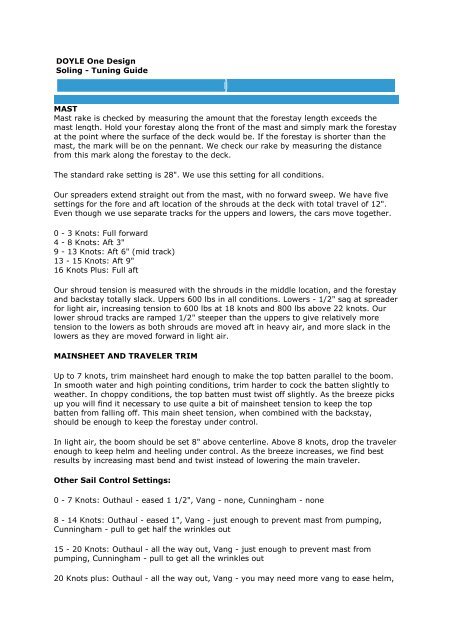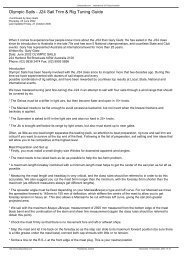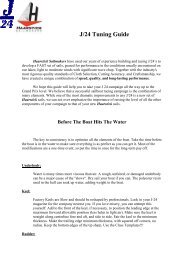DOYLE Soling One Design Tune.pdf - Sailmaker.org
DOYLE Soling One Design Tune.pdf - Sailmaker.org
DOYLE Soling One Design Tune.pdf - Sailmaker.org
You also want an ePaper? Increase the reach of your titles
YUMPU automatically turns print PDFs into web optimized ePapers that Google loves.
<strong>DOYLE</strong> <strong>One</strong> <strong>Design</strong><strong>Soling</strong> - Tuning GuideMASTMast rake is checked by measuring the amount that the forestay length exceeds themast length. Hold your forestay along the front of the mast and simply mark the forestayat the point where the surface of the deck would be. If the forestay is shorter than themast, the mark will be on the pennant. We check our rake by measuring the distancefrom this mark along the forestay to the deck.The standard rake setting is 28". We use this setting for all conditions.Our spreaders extend straight out from the mast, with no forward sweep. We have fivesettings for the fore and aft location of the shrouds at the deck with total travel of 12".Even though we use separate tracks for the uppers and lowers, the cars move together.0 - 3 Knots: Full forward4 - 8 Knots: Aft 3"9 - 13 Knots: Aft 6" (mid track)13 - 15 Knots: Aft 9"16 Knots Plus: Full aftOur shroud tension is measured with the shrouds in the middle location, and the forestayand backstay totally slack. Uppers 600 lbs in all conditions. Lowers - 1/2" sag at spreaderfor light air, increasing tension to 600 lbs at 18 knots and 800 lbs above 22 knots. Ourlower shroud tracks are ramped 1/2" steeper than the uppers to give relatively moretension to the lowers as both shrouds are moved aft in heavy air, and more slack in thelowers as they are moved forward in light air.MAINSHEET AND TRAVELER TRIMUp to 7 knots, trim mainsheet hard enough to make the top batten parallel to the boom.In smooth water and high pointing conditions, trim harder to cock the batten slightly toweather. In choppy conditions, the top batten must twist off slightly. As the breeze picksup you will find it necessary to use quite a bit of mainsheet tension to keep the topbatten from falling off. This main sheet tension, when combined with the backstay,should be enough to keep the forestay under control.In light air, the boom should be set 8" above centerline. Above 8 knots, drop the travelerenough to keep helm and heeling under control. As the breeze increases, we find bestresults by increasing mast bend and twist instead of lowering the main traveler.Other Sail Control Settings:0 - 7 Knots: Outhaul - eased 1 1/2", Vang - none, Cunningham - none8 - 14 Knots: Outhaul - eased 1", Vang - just enough to prevent mast from pumping,Cunningham - pull to get half the wrinkles out15 - 20 Knots: Outhaul - all the way out, Vang - just enough to prevent mast frompumping, Cunningham - pull to get all the wrinkles out20 Knots plus: Outhaul - all the way out, Vang - you may need more vang to ease helm,
Cunningham - pull hard to help ease helmBACKSTAYThere are two things the backstay does. Controls fullness in the main and controlsforestay sag. This is probably the most important adjustment in the <strong>Soling</strong>. The morebackstay tension, the flatter the main and the forestay tension flattens the jib. I have mybackstay marked at every two inches, so I can repeat fast settings and have the boatready quickly after mark roundings.MAINSHEET TENSIONThe mainsheet controls the top part of the mainsail. The quickest and most accurate wayto trim the mainsail is to watch the top batten. Sighting from under the boom, the topbatten should be parallel to the boom or slightly tighter most of the time, when not inoverpowered conditions. Under ideal conditions, (flat water) the top batten can point 5 -8 degrees to weather of centerline, and when overpowered, it should open fromcenterline until it balances the helm.BOOM VANGOur sails are designed so it is only necessary to use vang in a few situations. For upwindsailing, I use only enough vang to keep the mast from pumping, except in heavy airwhen I occasionally use vang to reduce helm.TRAVELERThe boom should be above centerline until both crew are "over the side" then thetraveler should be eased down to reduce weather helm. The traveler should be playedwith each puff in over 14 knots, but if the wind is steady, the backstay should beadjusted to depower the top of the mainsail and the traveler kept in the middle.Maximum out should be about 10" in 15 to 20 knots.When using the V-1 Jib, start with the sheet in the second hole from the top, when thesail is new. We slide the sail up or down the forestay to adjust the lead, instead ofmoving the holes. As the sail ages, it becomes necessary to go to the third hole.WIND CLEW HOLE TACK HGT. / LUFF TENSION / JIB TRAV.0 - 3 / 3 / 3" / Big wrinkles 12"4 - 6 / 3 / 3" / Big wrinkles 10"7 - 10 / 3 / 2.5" / Small wrinkles 10"11 - 15 / 3 / 2" / No wrinkles 11.5"I prefer to switch to the A-1 at about 12 knots, but the two sails will overlap well from 10- 15 knots. When using the A-1, put the sheet in the third hole from the top. Again, slidethe sail up and down for lead adjustment.
WIND / CLEW HOLE / TACK HGT. / LUFF TENSION / JIB TRAV.10 - 12 / 3 / 3" / Slight wrinkles 10"13 - 15 / 3 / 2.5" / Just smooth 10.5"16 - 18 / 3 / 2" / Smooth 11"19 - 22 / 3 / 1" / Smooth 12"23 plus / 3 / 0" / Smooth Down enough to prevent backwind.
















